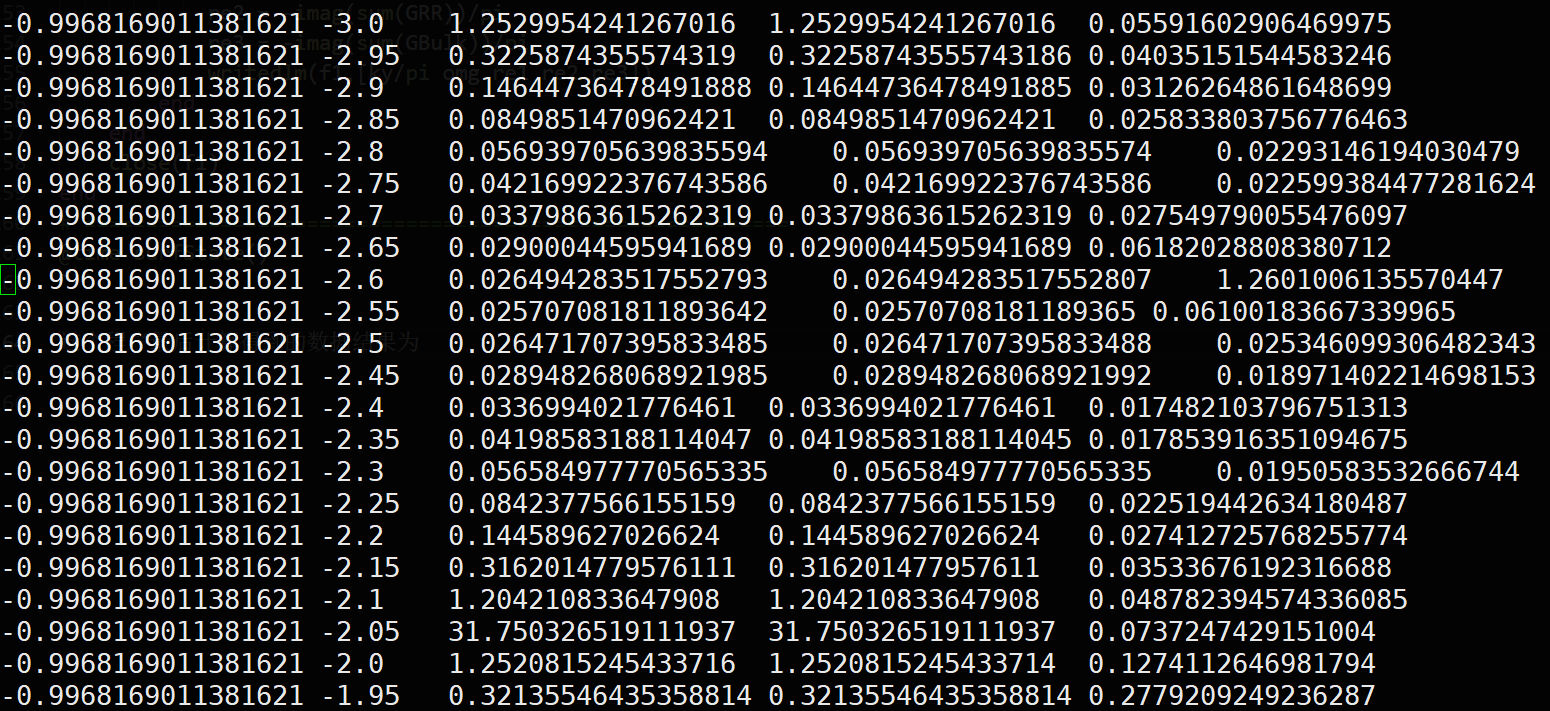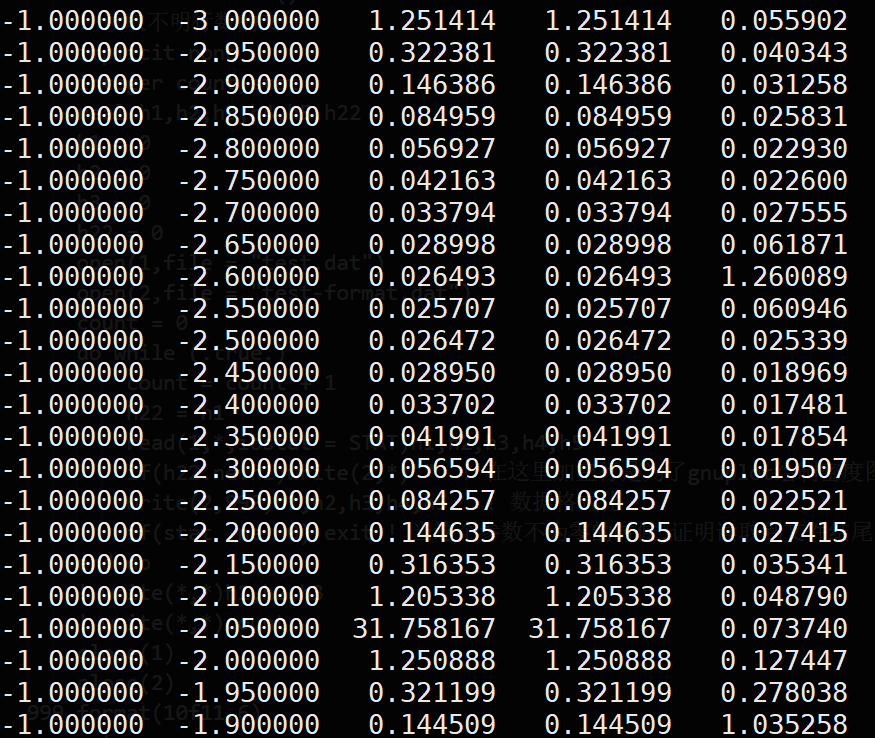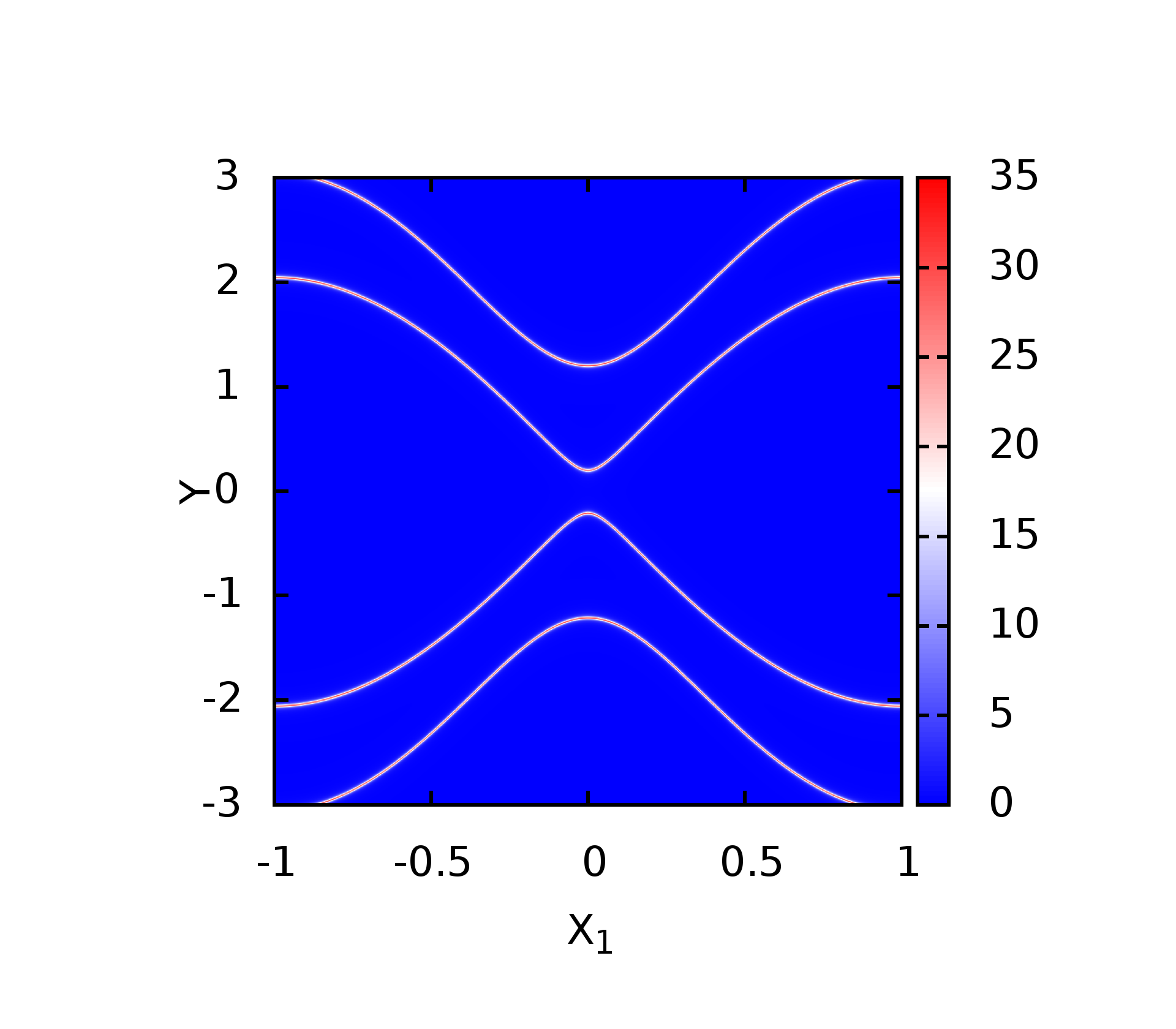这里整理一下利用Fortran将数值计算过程中由Julia计算出的数据进行格式化输出.
在利用Julia做计算的时候,始终不能将数据整理成格式化的形式,这里就只好借助于Fortran来将其输出的数据重新读入之后,在进行格式化操作,最后再输出了.先以一个Julia计算的程序为例
using LinearAlgebra,DelimitedFiles,PyPlot
#---------------------------------------------------
function Pauli()
hn = 4
g1 = zeros(ComplexF64,hn,hn)
g2 = zeros(ComplexF64,hn,hn)
g3 = zeros(ComplexF64,hn,hn)
#------ Kinetic energy
g1[1,1] = 1
g1[2,2] = -1
g1[3,3] = 1
g1[4,4] = -1
#-------- SOC-x
g2[1,2] = 1
g2[2,1] = 1
g2[3,4] = -1
g2[4,3] = -1
#---------- SOC-y
g3[1,2] = -1im
g3[2,1] = 1im
g3[3,4] = -1im
g3[4,3] = 1im
return g1,g2,g3
end
# ========================================================
function matset(ky::Float64)
hn::Int64 = 4
H00 = zeros(ComplexF64,4,4)
H01 = zeros(ComplexF64,4,4)
g1 = zeros(ComplexF64,4,4)
g2 = zeros(ComplexF64,4,4)
g3 = zeros(ComplexF64,4,4)
#--------------------
m0::Float64 = 1.5
tx::Float64 = 1.0
ty::Float64 = 1.0
ax::Float64 = 1.0
ay::Float64 = 1.0
g1,g2,g3 = Pauli()
#--------------------
for m in 1:hn
for l in 1:hn
H00[m,l] = (m0-ty*cos(ky))*g1[m,l] + ay*sin(ky)*g3[m,l]
H01[m,l] = (-tx*g1[m,l] - 1im*ax*g2[m,l])/2
end
end
#------
return H00,H01
end
# ====================================================================================
function surfgreen_1985(omg::Float64,ky::Float64)
hn::Int64 = 4
GLL = zeros(ComplexF64,hn,hn)
GRR = zeros(ComplexF64,hn,hn)
GBulk = zeros(ComplexF64,hn,hn)
iter::Int64 = 0
itermax::Int64 = 100
accuarrcy::Float64 = 1E-7
real_temp::Float64 = 0.0
omegac::ComplexF64 = 0.0
eta::Float64 = 0.01
#-----------------------------------
alphai = zeros(ComplexF64,hn,hn)
betai = zeros(ComplexF64,hn,hn)
epsiloni = zeros(ComplexF64,hn,hn)
epsilons = zeros(ComplexF64,hn,hn)
epsilons_t = zeros(ComplexF64,hn,hn)
mat1 = zeros(ComplexF64,hn,hn)
mat2 = zeros(ComplexF64,hn,hn)
g0 = zeros(ComplexF64,hn,hn)
unit = zeros(ComplexF64,hn,hn)
#------------------------------------
H00,H01 = matset(ky)
epsiloni = H00
epsilons = H00
epsilons_t = H00
alphai = H01
betai = conj(transpose(H01))
#-------------------------------------
for i in 1:hn
unit[i,i] = 1
end
#-------------------------------------
omegac = omg + 1im*eta
for iter in 1:itermax
g0 = inv(omegac*unit- epsiloni)
mat1 = alphai*g0
mat2 = betai*g0
g0 = mat1*betai
epsiloni = epsiloni + g0
epsilons = epsilons + g0
g0 = mat2*alphai
epsiloni= epsiloni + g0
epsilons_t = epsilons_t+ g0
g0 = mat1*alphai
alphai = g0
betai = g0
real_temp = abs(sum(alphai))
if real_temp < accuarrcy
break
end
end
GLL = inv(omegac*unit - epsilons)
GRR = inv(omegac*unit - epsilons_t)
GBulk = inv(omegac*unit - epsiloni)
return GLL,GRR,GBulk
end
# ==========================================================
function surfState()
hn::Int64 = 4
dk::Float64 = 0.01
domg::Float64 = 0.01
ky::Float64 = 0.0
omg::Float64 = 0.0
GLL = zeros(ComplexF64,hn,hn)
GRR = zeros(ComplexF64,hn,hn)
GBulk = zeros(ComplexF64,hn,hn)
f1 = open("edgeState.dat","w")
for ky in -pi:dk:pi
for omg in -3:domg:3
GLL,GRR,GBulk = surfgreen_1985(omg,ky)
re1 = -imag(sum(GLL))/pi
re2 = -imag(sum(GRR))/pi
re3 = -imag(sum(GBulk))/pi
writedlm(f1,[ky/pi omg re1 re2 re3])
end
end
close(f1)
end
# =========================================================
@time surfState()
这个程序最后计算得到的数据结果为

可以发现这样的数据格式非常不整齐,不太利于之后的操作,所以接下来就通过Fortran程序将这个数据文件读入,然后再格式化输出.
program main
implicit none
integer m1,m2,m3
call main1()
stop
end program
!=======================================================
subroutine main1()
! 读取不明行数的文件
implicit none
integer count,stat
real h1,h2,h3,h4,h5,h22
h1 = 0
h2 = 0
h3 = 0
h22 = 0
open(1,file = "test.dat")
open(2,file = "test-format.dat")
count = 0
do while (.true.)
count = count + 1
h22 = h1
read(1,*,iostat = STAT)h1,h2,h3,h4,h5
if(h22.ne.h1)write(2,*)"" ! 在这里加空行是为了gnuplot绘制密度图
write(2,999)h1,h2,h3,h4,h5 ! 数据格式化
if(stat .ne. 0) exit ! 当这个参数不为零的时候,证明读取到文件结尾
end do
! write(*,*)h1,h2,h3
! write(*,*)count
close(1)
close(2)
999 format(10f11.6)
return
end subroutine main1
首先来解释一下程序中的内容,因为再计算的时候,数据第一列是外部循环变量,所以先取定一个值保持不变,第二列的值遍历一次循环.因此当
do while (.true.)
count = count + 1
h22 = h1
read(1,*,iostat = STAT)h1,h2,h3,h4,h5
if(h22.ne.h1)write(2,*)"" ! 在这里加空行是为了gnuplot绘制密度图
write(2,999)h1,h2,h3,h4,h5 ! 数据格式化
if(stat .ne. 0) exit ! 当这个参数不为零的时候,证明读取到文件结尾
end do
第一列的值在读取的时候,不相等了,说明开始读取下一次外层循环了,这里就多加了一行空格,是为了利用gnuplot绘制密度图所用.而在文件读取的时候
read(1,*,iostat = STAT)h1,h2,h3,h4,h5
STAT这个量会反应是否读取到了文件的末尾,从而来判断循环过程时候中断.最后得到的数据如下图所示

将数据整理格式化之后,就可以利用gnuplot来绘制图像了
set encoding iso_8859_1
#set terminal postscript enhanced color
#set output 'arc_r.eps'
#set terminal pngcairo truecolor enhanced font ",50" size 1920, 1680
set terminal png truecolor enhanced font ",50" size 1920, 1680
set output 'density.png'
#set palette defined ( -10 "#194eff", 0 "white", 10 "red" )
set palette defined ( -10 "blue", 0 "white", 10 "red" )
#set palette rgbformulae 33,13,10
unset ztics
unset key
set pm3d
set border lw 6
set size ratio 1
set view map
set xtics
set ytics
#set xlabel "K_1 (1/{\305})"
set xlabel "X_1"
#set ylabel "K_2 (1/{\305})"
set ylabel "Y"
set ylabel offset 1, 0
set colorbox
set xrange [-1:1]
set yrange [-3:3]
set pm3d interpolate 4,4
#splot 'wavenorm.dat' u 1:2:3 w pm3d
#splot 'wavenorm.dat' u 1:2:3 w pm3d
splot 'test-format.dat' u 1:2:3 w pm3d

因为利用格林函数方法进行计算的时候,要想得到漂亮的图,取点间隔必须小,这样就会使得数据比较大,所以利用gnuplot绘图还是比较方便的.
代码下载
这些程序的源代码,可以点击这里下载
公众号
相关内容均会在公众号进行同步,若对该Blog感兴趣,欢迎关注微信公众号。

|
yxli406@gmail.com |